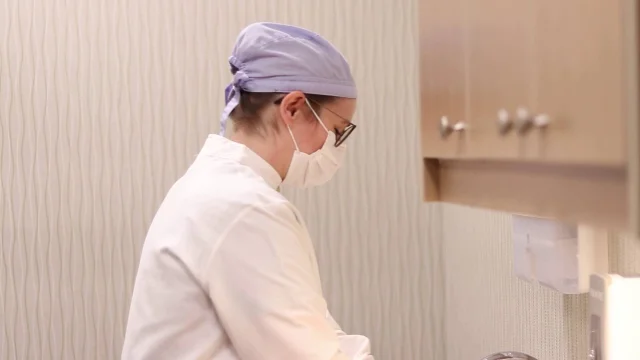By: Lindsey Hesse, RDH
What are the Benefits of Flossing?
How many times has your hygienist asked if you are flossing regularly, and you respond yes, even though you know you’ve only flossed twice in advance of this appointment? More than half of Americans don’t floss regularly and 20% don’t floss at all.1
Most people view flossing as an annoying chore. I get it, we all are tired at night and that extra step seems like it takes forever! But the trick is that it doesn't matter what time of the day you floss. The key to success is flossing consistently day after day. Even if you mess up a day here or there, flossing more days than not is what will keep your mouth healthy.
What Does Flossing Do?
Our body's immune response naturally responds to irritants by sending fluids to the area to help it heal. Think about getting a sliver in your finger. We get swelling and soreness, and when we squeeze the sliver out it bleeds. This is the body's way of healing, and the same is true for the gums.
We might have swelling, soreness, or bleeding in the gums, especially after flossing. This is how our body's inflammation response works. Much like the sliver in your finger, your body is trying to irrigate the food, plaque, and bacteria in your gums with this inflammation and bleeding. When we mechanically stimulate our gums by flossing, it triggers this inflammation response. A lot of my patients tell me that they don't floss because it makes their gums bleed. You may have heavier bleeding at first, but the more you floss, the less bleeding you will have.
There are many benefits to flossing, and once you work it into your routine, the time it takes you to floss goes down, and your mouth and gums will be healthier, causing them to no longer bleed.
5 Reasons Flossing is Important
- Flossing does 40% of the work in removing sticky bacteria, or plaque, from your teeth. Every tooth has five surfaces and when we don’t floss, we are immediately missing two of these surfaces. Plaque build-up can lead to swollen gums, tooth decay, and cavities, or gum disease.
- The rest of your body is healthier when you floss. When you have good oral health, you are reducing the risk of stroke, diabetes, rheumatoid arthritis, respiratory disease, and heart disease—all are linked to gum health and periodontitis. Flossing reduces and removes plaque between the teeth, promoting an overall healthier mouth.
- Prevent gingivitis. Gingivitis is an early stage of gum disease where gums become swollen and bleed easily. Healthy gums don’t bleed when you brush or floss. If your gums are bleeding, it is an indication you need to brush and floss more frequently.
- Low-cost, efficient tool to a healthy mouth. Flossing is a low-cost and easy way to prevent tooth decay and promote a healthy mouth. While some question how effective flossing is, we know it is not ineffective and helps keep gum tissues healthy. Plus, your dentist can tell right away during a routine cleaning whether you have been flossing regularly.
- Your smile will look better. Flossing will lead to better breath, whiter teeth, a more confident-smile. Spending just a couple of extra minutes will increase your overall health, making it an easy commitment to make to yourself and your body.
How to Floss Properly
- Use 12 to 18 inches of your preferred dental floss and wind most of the floss around each middle finger, leaving an inch or two of floss to work with.
- Holding the floss tightly between your thumbs and index fingers, gently slide the floss in between your teeth.
- Hug the floss against one of the surfaces of one of your teeth creating a C-shape with the floss.
- Scrape up and down against the entire tooth surface and make sure to get under the gums as far as you can go.
- Repeat this step by hugging the floss against the surface of the other tooth that you are working between.
- To remove the floss, use the same motion and bring the floss up and away from the teeth.
- Move tooth-to-tooth repeating this process and use a clean section of floss for each area. Remember to floss the backsides of your molars and even floss the sides of teeth that don’t have neighboring teeth.
What Does Flossing Do?
Not flossing allows harmful plaque and bacteria to grow in the mouth. Some bacteria can lead to cavities over time. However, gingivitis or gum inflammation can develop in the mouth from plaque and bacteria after only a few days. Gingivitis can develop into periodontal disease over time causing bone loss to the bone that holds the teeth in place. Brushing only cleans about two-thirds of the mouth, so flossing is important to clean the other one-third in those spaces that the toothbrush doesn't reach.
You can floss anywhere and at any time! I tell my patients to incorporate flossing into other daily activities such as flossing in the shower, leaving it by the TV, leaving it by your deck or favorite chair. Even flossing right before you brush can help instead of doing it afterward. Really, the possibilities are endless. Again, the success with flossing is doing it day after day, rather than the time of day that you do it.
If you have questions about your oral health or proper flossing technique, request an appointment with a dentist near you. Our teams are always happy to help you find the best ways to care for your oral health.


